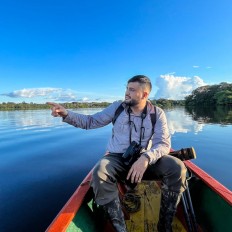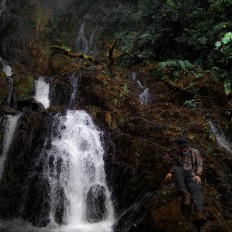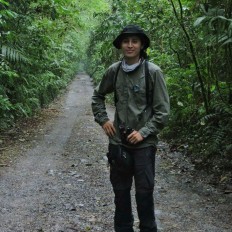It is recommended to enter in the early hours of the morning as it is the best time for birdinge. Around the visitor centeryou will find some feeders for tanagers and hummingbirds: some species are fairly common here: Andean Motmot, Blue-and-gray Tanager, Black-billed Thrush, Tick-billed Euphonia, Red-crowned Woodpecker, Scrub Tanager, Tropical Kingbird, Great Kiskadee, Rufous-tailed Hummingird, Steely-vented Hummigbird and Black-throated Mango.
Along the trail you will have chances to see the colombia endemic Grayish Piculet, Stripe-throated Hermit, Guira Tanager, and high in the tall trees you should look for the Tourquoise Dancnis. Important to look for Slaty Spinetail, Great Antrshike and Bar-crested Antshikre on the bushes and scrubby patches around the trail.
A recommendation is to walk around the trail around the Soccer Field because there is more often to connect with Blue-lored Antbird, Colombian form of Speckled Wren, Plain Antvireo and Scaled Antpitta. These species are more common around the main soccer field, in the forests that surround it and that connect with the paths of the botanical garden. It is recommended after doing the tour of the trail, because in large trees is where there are more possibilities to see the Tourquoise Dacnis. Here you can check the ebird info about this spot: https://ebird.org/hotspot/L3582397
Another recommended point is the bridge that connects with University Building No. 15. It is located about 300m from the soccer field and is a great place because the bridge cross through the forest and the canopy is on the eye level, so you have good options to see species at level, included Tourquoise Dacnis, Cocoa Woocreeper, Lineated Woodpecker, Crimson-rumped Toucanet, Black-winged Saltator, Squirrel Cuckoo, Blue-necked Tanager and others.
During the migration season (April-Sept) at this point it is common to see Summer Tanager, Blackburnian Warbler, American Redstar and some individuals of Cerulean Warbler. Another recommendation is always take a look at the small creek that is under the bridge because it is possible to see the Gray-headed Dove (Leptotila plumbeiceps). Here you can check the ebird info about this spot: https://ebird.org/hotspot/L6951963
It is recommended to enter in the early hours of the morning as it is the best time for birdinge. Around the visitor centeryou will find some feeders for tanagers and hummingbirds: some species are fairly common here: Andean Motmot, Blue-and-gray Tanager, Black-billed Thrush, Tick-billed Euphonia, Red-crowned Woodpecker, Scrub Tanager, Tropical Kingbird, Great Kiskadee, Rufous-tailed Hummingird, Steely-vented Hummigbird and Black-throated Mango.
Along the trail you will have chances to see the colombia endemic Grayish Piculet, Stripe-throated Hermit, Guira Tanager, and high in the tall trees you should look for the Tourquoise Dancnis. Important to look for Slaty Spinetail, Great Antrshike and Bar-crested Antshikre on the bushes and scrubby patches around the trail.
A recommendation is to walk around the trail around the Soccer Field because there is more often to connect with Blue-lored Antbird, Colombian form of Speckled Wren, Plain Antvireo and Scaled Antpitta. These species are more common around the main soccer field, in the forests that surround it and that connect with the paths of the botanical garden. It is recommended after doing the tour of the trail, because in large trees it is where there are more possibilities to see the Tourquoise Dacnis. Here you can check the ebird info about this spot: https://ebird.org/hotspot/L3582397
Another recommended point is the bridge that connects with University Building No. 15. It is located about 300m from the soccer field and it and is a great place because the bridge that is at the height of cross through the forest and the canopy that connects with is on the garden, and eye level, so you have very good have good options to see species at level, included Tourquoise Dacnis, Cocoa Woocreeper, Lineated Woodpecker, Crimson-rumped Toucanet, Black-winged Saltator, Squirrel Cuckoo, Blue-necked Tanager and others.
During the migration season (April-Sept) at this point it is common to see Summer Tanager, Blackburnian Warbler, American redstar and Redstar and some individuals of Cerulean Warbler. Another recommendation is always take a look at the ravine that small creek that is under the bridge because it is possible to see the Gray-headed Dove (Leptotila plumbeiceps). Here you can check the ebird info about this spot: https://ebird.org/hotspot/L6951963
It is recommended to enter in the early hours of the morning as it is the best time for birdinge. Around the visitor centeryou will find some feeders for tanagers and hummingbirds: some species are fairly common here: Andean Motmot, Blue-and-gray Tanager, Black-billed Thrush, Tick-billed Euphonia, Red-crowned Woodpecker, Scrub Tanager, Tropical Kingbird, Great Kiskadee, Rufous-tailed Hummingird, Steely-vented Hummigbird and Black-throated Mango.
Along the trail you will have chances to see the colombia endemic Grayish Piculet, Stripe-throated Hermit, Guira Tanager, and high in the tall trees you should look for the Tourquoise Dancnis. Important to look for Slaty Spinetail, Great Antrshike and Bar-crested Antshikre on the bushes and scrubby patches around the trail.
A recommendation is to walk aroun around the trail aroun around the Soccer Field because there is more often to connect with Blue-lored Antbird, Colombian form of Speckled Wren, Plain Antvireo and Scaled Antpitta.These species are more common around the main soccer field, in the forests that surround it and that connect with the paths of the botanical garden. It is recommended after doing the tour of the trail, because in large trees it is where there are more possibilities to see the Tourquoise Dacnis. Here you can check the ebird info about this spot: https://ebird.org/hotspot/L3582397
Another recommended point is the bridge that connects Building No. 15. It is located about 300m from the soccer field and it is a bridge that is at the height of the forest canopy that connects with the garden, and you have very good options to see species at level, included Tourquoise Dacnis, Cocoa Woocreeper, Lineated Woodpecker, Crimson-rumped Toucanet, Black-winged Saltator, Squirrel Cuckoo, Blue-necked Tanager and others.
During the migration season at this point it is common to see Summer Tanager, Blackburnian Warbler, American redstar and some individuals of Cerulean Warbler. Another recommendation is always take a look at the ravine that is under the bridge because it is possible to see the Gray-headed Dove (Leptotila plumbeiceps). Here you can check the ebird info about this spot: https://ebird.org/hotspot/L6951963
It is recommended to enter in the early hours of the morning as it is the best time for birdinge. Around the visitor centeryou will find some feeders for tanagers and hummingbirds: some species are fairly common here: Andean Motmot, Blue-and-gray Tanager, Black-billed Thrush, Tick-billed Euphonia, Red-crowned Woodpecker, Scrub Tanager, Tropical Kingbird, Great Kiskadee, Rufous-tailed Hummingird, Steely-vented Hummigbird and Black-throated Mango.
Along the trail you will have chances to see the colombia endemic Grayish Piculet, Stripe-throated Hermit, Guira Tanager, and high in the tall trees you should look for the Tourquoise Dancnis. Important to look for Slaty Spinetail, Great Antrshike and Bar-crested Antshikre on the bushes and scrubby patches around the trail.
A recommendation is to walk aroun the trail aroun the Soccer Field because there is more often to connect with Blue-lored Antbird, Colombian form of Speckled Wren, Plain Antvireo and Scaled Antpitta.These species are more common around the main soccer field, in the forests that surround it and that connect with the paths of the botanical garden. It is recommended after doing the tour of the trail, to do it around the soccer fields, because in large trees it is where there are more possibilities to see the Dacnis HYaTourquoise Dacnis. Here you can check the ebird info about this spot: https://ebird.org/hotspot/L3582397
Another recommended point is the bridge that connects Building No. 15. It is located about 300m from the soccer field and it is a bridge that is at the height of the forest canopy that connects with the garden, and you have very good options to see species at level, included Tourquoise Dacnis, Cocoa Woocreeper, Lineated Woodpecker, Crimson-rumped Toucanet, Black-winged Saltator, Squirrel Cuckoo, Blue-necked Tanager and others.
During the migration season at this point it is common to see Summer Tanager, Blackburnian Warbler, American redstar and some individuals of Cerulean Warbler. Another recommendation is always take a look at the ravine that is under the bridge because it is possible to see the Gray-headed Dove (Leptotila plumbeiceps). Here you can check the ebird info about this spot: https://ebird.org/hotspot/L6951963
These species are more common around the main soccer field, in the forests that surround it and that connect with the paths of the botanical garden. It is recommended after doing the tour of the trail, to do it around the soccer fields, because in large trees it is where there are more possibilities to see the Dacnis HYa




